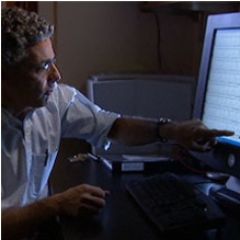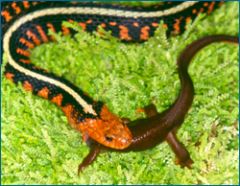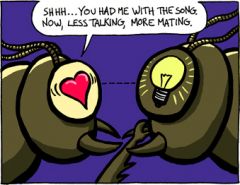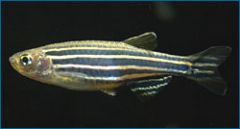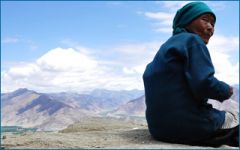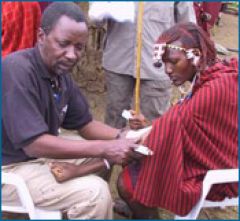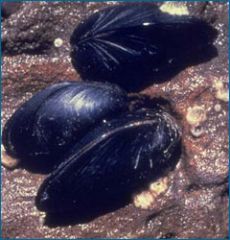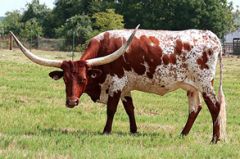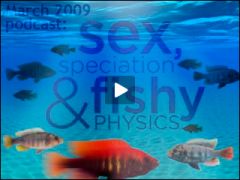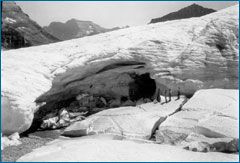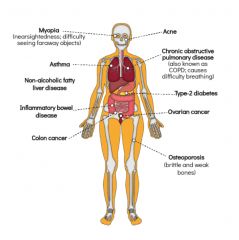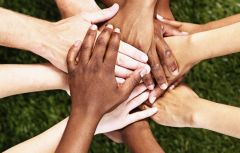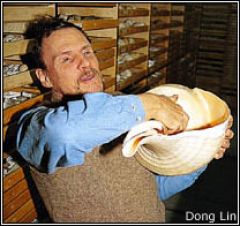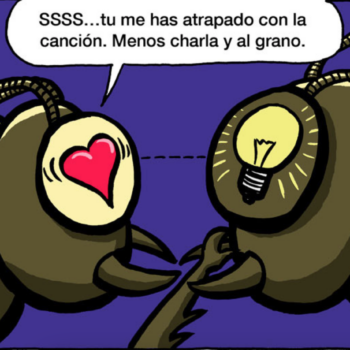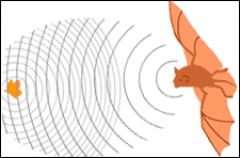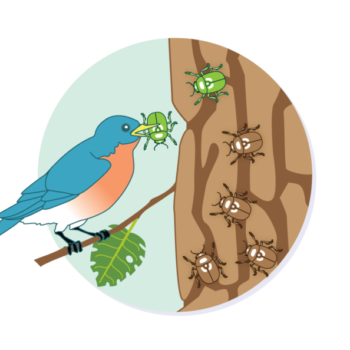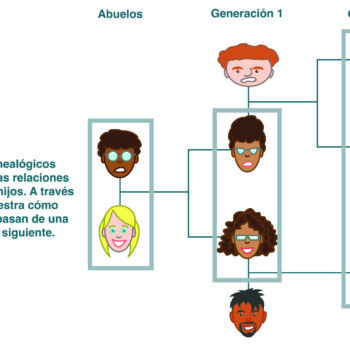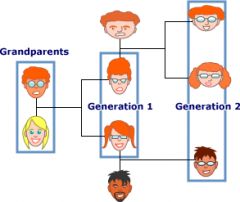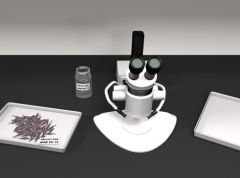Found 33 resources for the concept:
There is a fit between organisms and their environments, though not always a perfect fit. (LS4.C)
Adaptation to altitude
Grade Level(s):
- 9-12
- 13-16
Source:
- Smithsonian National Museum of Natural History
Resource type:
- Classroom activity
Time: Eight 50-minute class periods
Overview
In this set of sequenced lessons, students learn how to devise an experiment to test the difference between acclimation and adaptation; investigate how scientific arguments show support for natural selection in Tibetans; design an investigation using a simulation based on the Hardy-Weinberg principle to explore mechanisms of evolution; and devise a test for whether other groups of people have adapted to living at high altitudes.
Adaptation: The case of penguins
Grade Level(s):
- 9-12
- General
Source:
- Visionlearning
Resource type:
- Article
Time: 20 minutes
Overview
The process of natural selection produces stunning adaptations. Learn about the history of this concept, while you explore the incredible adaptations that penguins have evolved, allowing them to survive and reproduce in a climate that reaches -60°C!
This article appears at Visionlearning.
Allele and phenotype frequencies in rock pocket mouse populations
Grade Level(s):
- 9-12
- 13-16
Source:
- Howard Hughes Medical Institute
Resource type:
- Classroom activity
Time: One or two class 50-minute periods
Overview
This video and worksheet use real rock pocket mouse data collected by Dr. Michael Nachman and his colleagues to illustrate the Hardy-Weinberg principle.
Biological warfare and the coevolutionary arms race
Grade Level(s):
- 9-12
- 13-16
- Advanced
- General
Source:
- UC Museum of Paleontology
Resource type:
- Article
Time: 45 minutes
Overview
The rough-skinned newt looks harmless enough but is, in fact, packed full of one of the most potent neurotoxins known to man. Find out how an evolutionary arms race has pushed these mild-mannered critters to the extremes of toxicity and how evolutionary biologists have unraveled their fascinating story.
Comic strip: Survival of the sneakiest
Grade Level(s):
- 6-8
- 9-12
- General
- Student
Source:
- UC Museum of Paleontology
Resource type:
- Comic
Time: 10 minutes
Overview
This comic follows the efforts of a male cricket as he tries to attract a mate, and in the process, debunks common myths about what it means to be evolutionarily "fit."
Evidencias de la Evolución: La ciencia de la evolución
Grade Level(s):
- 6-8
- 9-12
- General
Source:
- UC Museum of Paleontology
Resource type:
- Tutorial
Time: 30-40 minutes
Overview
Evo in the news: A fish of a different color
Grade Level(s):
- 9-12
- 13-16
- General
Source:
- UC Museum of Paleontology
Resource type:
- Evo in the News article
Time: 15 minutes
Overview
This news brief, from February 2006, describes how a mutated zebrafish gene may help us understand human evolution and the genes underlying human skin color. Humans and zebrafish both inherited the same pigmentation gene from their common ancestor.
Evo in the news: Conserving the kakapo
Grade Level(s):
- 9-12
- 13-16
- General
Source:
- UC Museum of Paleontology
Resource type:
- Evo in the News article
Time: 15 minutes
Overview
This news brief, from April 2006, chronicles how researchers are using evolutionary theory to guide their strategies for conserving a critically endangered parrot - with some impressive results!
Evo in the news: Evolving altitude aptitude
Grade Level(s):
- 9-12
- 13-16
- General
Source:
- UC Museum of Paleontology
Resource type:
- Evo in the News article
Time: 10 minutes
Overview
This news brief from October 2010 examines new research that makes it clear that Tibetan highlanders have not just acclimated to their mountain home; evolutionary adaptations have equipped them with unique physiological mechanisms for dealing with low oxygen levels.
Evo in the news: Got lactase?
Grade Level(s):
- 9-12
- 13-16
- Advanced
- General
Source:
- UC Museum of Paleontology
Resource type:
- Evo in the News article
Time: 20 minutes
Overview
The ability to digest milk is a recent evolutionary innovation that has spread through some human populations. This news brief from April 2007 describes how evolution has allowed different human populations to take advantage of the nutritional possibilities of dairying and links evolution with the prevalence of lactose tolerance among people of different ethnicities.
Evo in the news: Musseling in on evolution
Grade Level(s):
- 9-12
- 13-16
- General
Source:
- UC Museum of Paleontology
Resource type:
- Evo in the News article
Time: 15 minutes
Overview
This news brief, from September 2006, reviews a recent case of evolution in action. In just 15 years, mussels have evolved in response to an invasive crab species. Find out how biologists uncovered this example of evolution on double time.
Evo in the news: No more mystery meat
Grade Level(s):
- 9-12
- 13-16
- General
Source:
- UC Museum of Paleontology
Resource type:
- Evo in the News article
Time: 20 minutes
Overview
This news brief from April 2013 describes new research on the origin of American cattle breeds. The story told by the cows' genes crisscrosses the trajectory of human evolutionary history from wild aurochs that lived alongside Neanderthals, to Christopher Columbus and, ultimately, the American West.
Evo in the news: Sex, speciation, and fishy physics
Grade Level(s):
- 9-12
- 13-16
- Advanced
- General
Source:
- UC Museum of Paleontology
Resource type:
- Evo in the News article
Time: 20 minutes
Overview
More than 500 species of cichlid fish inhabit Africa's Lake Victoria. This news brief from March 2009 explains new research suggesting that the physics of light may have played an important role in cichlid diversification and in the recent drop in their diversity.
Evo in the news: Warming to evolution
Grade Level(s):
- 9-12
- 13-16
- General
Source:
- UC Museum of Paleontology
Resource type:
- Evo in the News article
Time: 15 minutes
Overview
Global warming increasingly affects many aspects of our environment, from the sea level to tropical storm strength. But that's far from the full story. This news brief from July 2006 describes how global warming has already begun to affect the evolution of several species on Earth.
Evolution and health: What is a mismatch disease?
Grade Level(s):
- 9-12
Source:
- BiteScis
Resource type:
- Classroom activity
Time: 50 minutes
Overview
In this reading-, writing-, and discussion-based activity, students learn about how changes in the environment can influence the phenotype of organisms. More specifically, students will be investigating the concept of a mismatch disease and how it relates to many present human phenotypes that are no longer beneficial.
Evolution of human skin color
Grade Level(s):
- 9-12
- 13-16
Source:
- Smithsonian National Museum of Natural History
Resource type:
- Classroom activity
Time: Seven to ten 50 minute class periods
Overview
Students examine evidence for the relationship between UV and melanin in other animals; investigate the genetic basis for constitutive skin color humans; learn to test for natural selection in mouse fur color; investigate how interactions between UV and skin color in humans can affect fitness; and explore data on migrations and gene frequency to show convergent evolution of skin color.
Interview: Geerat Vermeij on the Fossil record
Grade Level(s):
- 9-12
- Advanced
- General
Source:
- California Academy of Sciences
Resource type:
- Interview with Scientist
Time: 20-30 minutes
Overview
This interview with MacArthur Fellow and paleobiologist, Geerat Vermeij, covers much ground, including adaptations in the mollusks he studies, evolutionary arms races, punctuated equilibrium, extinctions, macroevolution, and the value of diversity.
La Supervivencia del más Astuto
Grade Level(s):
- 6-8
- 9-12
- General
- Student
Source:
- UC Museum of Paleontology
Resource type:
- Comic
Time: 10 minutes
Overview
Este cómic nos habla de los esfuerzos de un grillo macho para atraer a una pareja. Y en el proceso, revela (destruye) algunos típicos malentendidos sobre lo que significa estar evolutivamente “adaptado”.
Lines of evidence: The science of evolution
Grade Level(s):
- 6-8
- 9-12
- General
Source:
- UC Museum of Paleontology
Resource type:
- Tutorial
Time: 30-40 minutes
Overview
The theory of evolution is broadly accepted by scientists — and for good reason! Learn about the diverse and numerous lines of evidence that support the theory of evolution.
Mecanismos: Los procesos de la evolución
Grade Level(s):
- 9-12
- General
Source:
- UC Museum of Paleontology
Resource type:
- Tutorial
Time: Varies
Overview
Aprende sobre los procesos básicos que han moldeado la vida y producido su asombrosa diversidad.
Este artículo se encuentra en Evolución 101.
Mechanisms of evolution
Grade Level(s):
- 9-12
- General
Source:
- UC Museum of Paleontology
Resource type:
- Tutorial
Time: Varies
Overview
Learn about the basic processes that have shaped life and produced its amazing diversity.
This article is located within Evolution 101.
Mejores biocombustibles gracias a la evolución
Grade Level(s):
- 9-12
- 13-16
- General
Source:
- UC Museum of Paleontology
Resource type:
- Evo in the News article
Time: 20 minutes
Overview
Actualmente, la mayoría de nosotros llenamos nuestro tanque de gasolina con combustibles fósiles, es decir, restos de plantas y animales que murieron muchos millones de años atrás y eventualmente se convirtieron en petróleo — pero, por supuesto, esto no puede perdurar para siempre. El petróleo es un recurso limitado y en algún momento se va a terminar. Para ayudar a solucionar este problema, muchos científicos, políticos, gente de negocios y ciudadanos preocupados han puesto sus esperanzas en los biocombustibles...
Natural selection: The basics
Grade Level(s):
- 9-12
- General
Source:
- UC Museum of Paleontology
Resource type:
- Tutorial
Time: 30-40 minutes
Overview
Darwin's most famous idea, natural selection, explains much of the diversity of life. Learn how it works, explore examples, and find out how to avoid misconceptions.
This article is located within Evolution 101.
Origami Birds
Grade Level(s):
- 9-12
Source:
- ENSI
Resource type:
- Classroom activity
Time: Three to four class periods
Overview
Students build and evolve and modify paper-and-straw "birds" to simulate natural selection acting on random mutations.
Selección natural
Grade Level(s):
- 9-12
- General
Source:
- UC Museum of Paleontology
Resource type:
- Tutorial
Time: 30-40 minutes
Overview
La idea más famosa de Darwin, “La selección Natural”, explica la gran diversidad de la vida. Aprende cómo funciona, explora algunos ejemplos, y descubre cómo evitar falsas ideas.
Este artículo se encuentra en Evolución 101.
Semejanzas y diferencias: Comprendamos las homologías y evolución convergente (nivel bachillerato)
Grade Level(s):
- 9-12
- General
- Student
Source:
- UC Museum of Paleontology
Resource type:
- Online activity or lab
Time: 30 minutes
Overview
Esta investigación interactiva explica qué son las homologías, cómo reconocerlas y cómo es que evolucionan.
Sexo, especiación y física subacuática
Grade Level(s):
- 9-12
- 13-16
- Advanced
- General
Source:
- UC Museum of Paleontology
Resource type:
- Evo in the News article
Time: 20 minutes
Overview
Evolución en las noticias relata una reciente historia que señala como comprender física básica puede revelar como la evolución esta ocurriendo hoy — en especial, como la física de la luz tiene influencia sobre la selección sexual, especiación y el colapso de la biodiversidad, producto de la polución causada por los humanos...
Similarities and differences: Understanding homology and convergent evolution
Grade Level(s):
- 9-12
- General
- Student
Source:
- UC Museum of Paleontology
Resource type:
- Online activity or lab
Time: 30 minutes
Overview
This interactive investigation explains what homologies are, how to recognize them, and how convergent traits evolve.
Stickleback Evolution Virtual Lab
Grade Level(s):
- 9-12
- 13-16
Source:
- Howard Hughes Medical Institute
Resource type:
- Online activity or lab
Time: 3 hours
Overview
This virtual lab teaches skills of data collection and analysis to study evolutionary processes using stickleback fish and fossil specimens.
Testing a hypothesis
Grade Level(s):
- 9-12
Source:
- Howard Hughes Medical Institute
Resource type:
- Classroom activity
Time: 50 minutes
Overview
Students watch a short film about natural selection in humans and answer questions on a worksheet that reinforce the evolutionary story behind malaria and sickle cell anemia prevalence.
The Making of the Fittest: Natural Selection and Adaption
Grade Level(s):
- 6-8
- 9-12
- 13-16
- Student
Source:
- Howard Hughes Medical Institute
Resource type:
- Video
Time: 10 minutes
Overview
This 10-minute film describes the research of Dr. Michael Nachman and colleagues, whose work in the field and in the lab has documented and quantified physical and genetic evolutionary changes in rock pocket mouse populations.
The Making of the Fittest: Natural Selection in Humans
Grade Level(s):
- 9-12
- 13-16
- Student
Source:
- Howard Hughes Medical Institute
Resource type:
- Video
Time: 15-30 minutes
Overview
This 14-minute film describes the connection between the infectious parasitic disease malaria and the genetic disease sickle cell anemia - one of the best-understood examples of natural selection in humans.
The Making of the Fittest: The Birth and Death of Genes
Grade Level(s):
- 6-8
- 9-12
- 13-16
- Student
Source:
- Howard Hughes Medical Institute
Resource type:
- Video
Time: 15-20 minutes
Overview
This 13-minute film describes how scientists have pieced together the evolutionary history of the Antarctic icefish by studying its genome – an excellent case study for genetic evolution as both the gain and loss of genes have led to key adaptations.


